Behringer releases updated images of the developing DS-80 synthesizer
A couple of weeks ago we saw renders of Behringer’s attempt at a clone of the Yamaha CS-80 polyphonic synthesizer. It took in a lot of the beats of the original but many people were unhappy (as people always are) about the layout. Behringer took these comments on board and has reworked it into a second design that Uli Behringer is offering up for our consideration.
DS-80 design take 2
The biggest criticism of the original design was about that weird bank of mini sliders on the left which we’ve all come to understand as being the classically primitive patch management system that was hidden away under a panel on the CS-80. This was largely deemed as unnecessary in these days of microcontrollers and computerised patch management. Although I’ve also heard it argued that the patch system on the CS-80 was voltage based with all the subtlety, resolution and drift that that implies. Replacing it with a computerised rendering would not be in keeping with the original synthesizer. It’s interesting to note that the DS-80 seems to retain the idea of just 4 user presets, but places them over by a little screen and a data knob which makes you wonder what information that’s going to display.
Many of the performance controls that were just above the keyboard on the first DS-80 design are now up on the left were the preset sliders used to be. That looks better but also puts the performance controls far away from where they want to be – right above the keyboard. They’re also persisting with sliders whereas the original CS-80 had paddles for those controls. If you’re trying to replicate an instrument then the way it was played and how you express yourself through it has to be important.
One thing they did get right is that the ribbon controller is now the full width of the keyboard – that’s better!
I imagine we’ll see at least one other iteration of this design before they even entertain the idea of building one. In some ways if they are implementing a computerised patch system then why keep the Tone Selector? It’s authentic and looks great but if you are trying to keep the size of the instrument down and they are just for show then it would perhaps be better to place the performance controls in that space.
We’ll see how things develop.
More information
- Uli Behringer’s Facebook post.
17 responses to “Behringer releases updated images of the developing DS-80 synthesizer”
 4,5 / 5,0 |
4,5 / 5,0 | 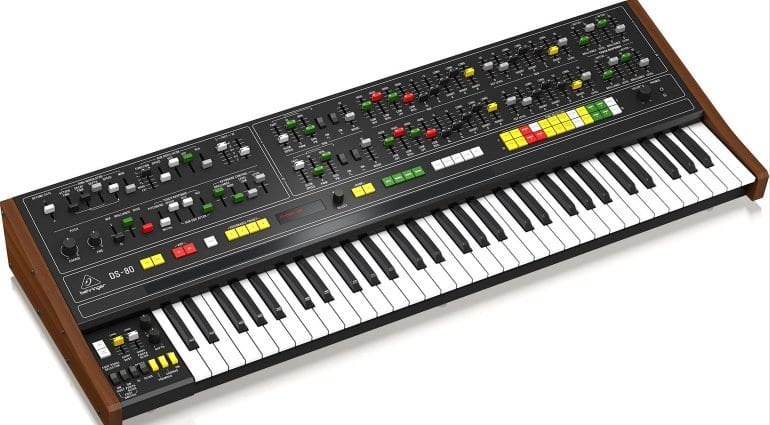
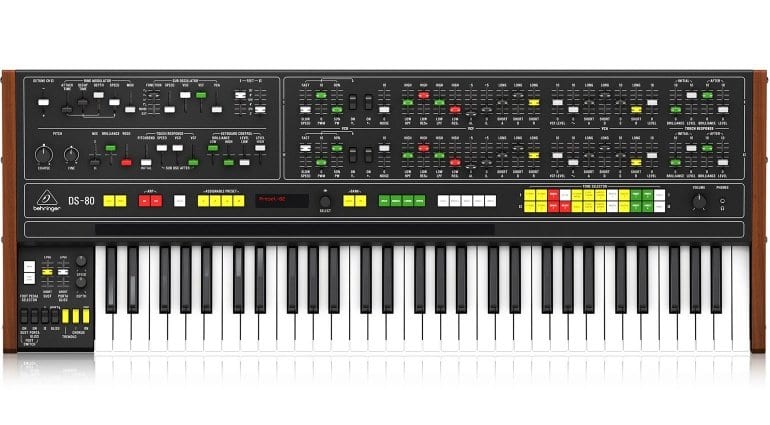


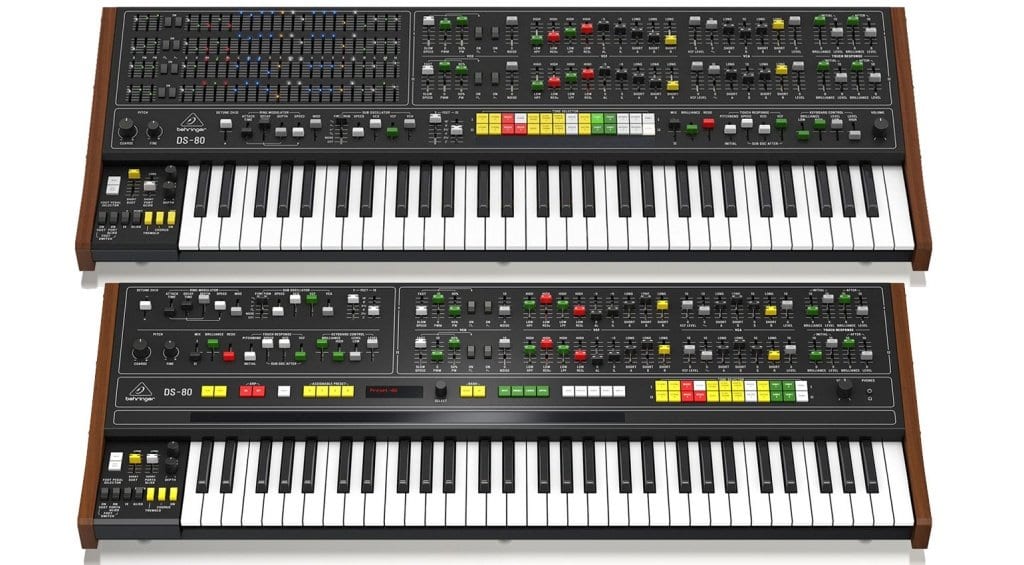
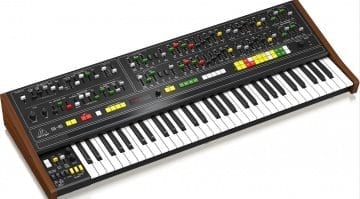

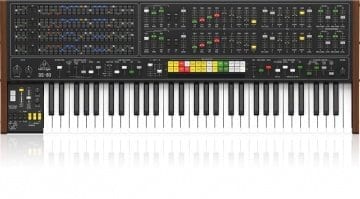
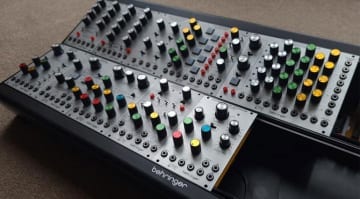
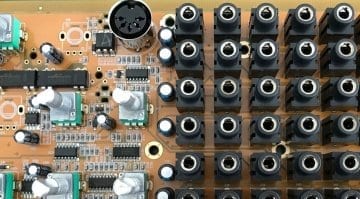

Nice BAR (big a** ribbon)!
Why the strip the entire length of the keyboard? The CS-80 had a five octave keybed with the strip extending for the bottom three octaves. What exactly is the point of a pitch strip in the top two octaves where it’s damn near impossible to use without your left hand crossing over your right?
Hopefully, if this is a final render, the strip can be defined to ignore that top two octaves. On the whole, you manipulate the strip with your LH while your RH plays the keys. Personally, I think this is dumb, raising the cost of the unit for a strip two octaves longer than it needs to be. Not to mention that, if the CS-80’s strip behavior is emulated (one octave up bottom to top, top to bottom pushes the oscillators into LFO range), a strip two octaves longer makes trilling and hammer-on/off distances greater than they used to be.
As slavish as Behringer often is, I don’t quite see the point of departing from the strip length. Yamaha was always the master of the machine/human interface, and the strip length/feel/pitch throw is part of what made it the legend it is.
Honestly I just think it’s a visual design decision because it fits nicely and a reaction to everyone complaining about how small the ribbon was on the first design. And a ribbon can control more than pitch so it doesn’t have to confine itself to the original purpose.
I doubt many complaining about the small ribbon size have ever played one. I have (and the CS-60). Trust me, the original strip was a wonder of ergonomics, the perfect size, in the perfect place. How many people play the keys with their LH and use the right for strip manipulation? Yamaha knew how many…!
If you zoom in on the picture, the ribbon runs 3 octaves in the 2nd design.
Oh when will you remaining dinosaurs of the ” We’ll hate everything Behringer create, no matter HOW brilliant it is” give it a rest?!!?
The first draft is published and what do we get: ” Oh whinge, whinge, the touch strip is too SHORT!”
The second draft is published, and: “Oh whinge, whinge, the touch strip is too LONG!”
What are you, the 3 Bears from Goldilocks??!!??
For god’s sake give it a rest, because you’re sounding pretty pathetic!
I bet Mr “Destinkeys” thinks the worldwide, record-breaking success of the genius “X32” was a total fluke and that it’s poorly designed rubbish!!
As I speak, and insofar as I’m aware, Uli and his mainly British team, are currently developing:- “The UBXa”, an “emu Sampler clone”, the much touted “j8″ clone, as well as the very early stages of the CS-80 clone!!
How on earth can ANY genuine musician/studio owner find anything negative in any of that?…….
……… And PLEASE don’t anyone embarrass themselves by trotting out the usual: ” But all Behringer kit is crap, falls to pieces when the pet canary lands on it, and is rubbish anyway!! ”
I’ve been using Behringer equipment for over 30 years ( since THE iconic, and game-changing compressor! ) and I have NEVER had a single unit fail yet! – and, incidentally, just in case you think we’re some type of “budget-bedroom” outfit, I’m proud to say that the 600th commercially produced and released album, created in our two studios, was completed two weeks ago!!
I have no doubt that, however long it takes to bring their CS-80 to market, whatever the final design is, and however much some of you lot still boringly moan, on and on about nit-picking stuff, which, in the real world of the studio or the stage, doesn’t matter a fig — you’re ALL, ( in the only place you’re totally honest, which is inside your own heads! ) going to WANT ONE!!
Because, trust me, if Yamaha proceed with this pipe-dream of recreating the original ( which, at the end of the day, I very much doubt they will! ) then I guarantee that it’ll cost closer to £5000 than £4000!! – and good luck with that!?!
Equally, I can almost equally guarantee, that the Behringer won’t cost more that £1200 – and probably less than that!!
And finally, for the few who may still be awake, and also back to the specific post I’m replying to: ” Yamaha was always the master of the machine/human interface “!!??!!
Oh Mr Destinkeys, PLEASE tell me you’re being (VERY) ironic? If not, go do some research on the history of Yamaha Musical Instrument division — and then hang your, obviously prejudiced, head in shame, my friend.
Take it easy all
Word!
Ever tried decaf? And paragraph breaks..?!
Look, it’s simple. Either you’ve played one or you haven’t. If you have, you know it was the ergonomics and controller quality that made it the legend it is. If you haven’t, all you can do is salivate over a clone that might help you convince yourself you are the second coming of Vangelis. And miss what it was that made guys like Vangelis use it in the first place.
The rest of your diatribe is utterly invented. I have nothing against Behringer gear, still have some. Try reading before you go off half-cocked, young man! I don’t hate Behringer, if they get this right (they didn’t publish a first draft and then make adjustments after input from us ‘dinosaurs’ because they were already committed to the design!). The fact that they have already made adjustments, certainly seems to show Behringer value the opinions of people like us that actually HAVE played and used the original more than someone that seems to show no knowledge of the original.
But who knows..? Perhaps they can take your advice, slap it out half-baked with little attention to detail and rely on those with no idea why it was great in the first place to make their sales quotas. That sounds like a GREAT strategy, right?
Well!! So your incisive reply rests on questioning how hyper I sound – and then criticising my grammar?!? How blindingly brilliant must be your wit!
Should you actually possess any, that is!
Your assertions/
intimations/
inferences/ –
– (I want to try and hit-on the correct term! Far be it from me to offend your obvious sensitivities regarding the written word!) –
– concerning my “criticism” of your post, leave me almost breathless with disbelief, — whilst, at the same time, wearing a very knowing, and, I happily confess, self-satisfied, smile at your obvious “insight” into my total lack of any knowledge about anything I wrote in my ( admittedly “passionate” , ( and make the most of that because it’s the only slight concession you’ll get from me concerning your ridiculously childish reply! ), “diatribe”!!
“Young man” (?!?) – I am proud to say I’ll be 70 in July, have been a professional musician the whole of my adult life, nurtured my Family and raised two beautiful daughters on nothing but my own “talent” ( if that’s what others choose to call it? ), “creativity” ( I refer you to the previous bracketed comment!! ), and energy!
I performed at the “Airplane” Festval in ’68, the “Dylan” Festival in ’69, and, you’ll not be surprised, the “historic”, yet, in truth, ( for those musicians who were involved! ), wholly chaotic 1970 Afton debacle!!
I’ve played the “Troubadour” on “The Strip” ( where I had, on one notable occasion, to change a string on James Taylor’s guitar ), The Marquee on several memorable ( and cramped!! ) nights, and have played almost every venue worth talking about, from the West Coast to Dubai – and then some!
And am I illustrating that, very small, part of my career as an exercise in ego-massaging? Setting myself apart from “you mere mortals” —
–Oh no, no!! I promise you I have no such intention!
It’s actually because, through all those decades I’ve gained as much of an instinct about people as I have about music and it’s creation , performance and recording! —
— And you, “my friend” are a typical internet poser, who undoubtedly gets most ( if not all? ) of his “knowledge” from Wikipedia etc, and I can almost guarantee, has never come closer than his own fantasies, to performing with an original CS-80 ……. Wheras I had the, (not very pleasurable, at the time!), experience of 6 nights of our ( very well known, and ruggedly handsome!) keyboard player, desperately trying to get the thing to behave in any way that might be termed “stable”!!
He did NOT succeed!!
( Incidentally, “Dest” — how’s your music career been going buddy?? )
You quote stats, and what some pros would call “tech-tripe”! –
All the convenient stuff you can leech from the ‘net!
NOTHING about how an instrument feels when you play it!
Whether it instantly wants to be your friend – or whether it’s fighting you from the moment of pure anticipation ( and hope! ) when you first lay your fingers on it.
Will the keybed be flabby and imprecise? Is it as easy to programme as we thought?
Will the action be too high, or the pickups too weak and wimpy?
Is this PA as clean as it sounded when we dem’d it?
No no no my friend! You may be many things —
But your no musician! At least, not one who’s ever achieved anything!
And, finally, — Do you know the little passing comments that revealed the true “height of you knowledge”??
Uli Behringer would never : ” slap ( anything!) out, half-baked” as you infer!!
And insofar as “quotas” or profit on these recreated analogue synths is concerned — anyone who actually KNOWS(!!) the guy will witness he doesn’t give a damn!
His assertions that Behringer will lose hundreds of k on this “analogue-mission” is most definitely not some marketing ploy!!
It’s genuine, believe me – or not, as you see fit!
And ( REALLY) finally!
Why am I having such a rip at poor old “Destin”?
I’ll tell you why folks!
Because, although the internet is a wonderful, beautiful, thing, ( especially, in my, obviously prejudiced opinion, for all musicians, of whatever ability or interest ), it has bred a certain breed of person:
The “know-all” who, actually, knows and has experienced, precisely — nothing!
Be careful before you believe a word they say!
Take it easy all
Aaaaaaaactually, if you squint, you’ll see that the strip **IS** only across the bottom three octaves. There’s space on either side of it, but it looks like only those three have an active strip.
It’s possible that’s some kind of visual artifact, but it would be a seriously odd coincidence if it just HAPPENED to stop at the bottom of the first octave and the top of the third.
So…. yeah?
So who’s going to re-issue a CS80 first? Yamaha or Behringer? Yamaha have been openly talking about the concept – but it looks like Behringer are going to kill it for them!
“but if you are trying to keep the size of the instrument down”
Why would they “try to keep the size of the instrument down?” At 5 octaves on the keybed, there isn’t much they can do to make it smaller, and if they cut it to 4 octave, they’ll lose a lot of real musicians that actually still play the instruments.
..Joe
It’s not the number of octaves, it’s about the depth and weight of the machine. The CS-80 is a huge monster of a device which is one of the major criticisms of it as an instrument.
Okay, got to weigh in on this: 1st: YES PLEASE. I’ll take one if it is anything approaching the quality and fidelity of the D. 2nd: regarding the size and position of the ribbon. Having any of the ribbon across the right side of the keyboard doesn’t bother me at all. My left hand crosses over my right while playing just fine. It would be no different than reaching over to adjust a filter cutoff frequency or any other controller that happened to be in that direction while playing. Here’s why that ribbon should be as long as possible – If (as they absolutely must if they’re going to build a worthy clone) they follow the original CS-80 design, wherever the ribbon is first touched becomes the zero-position for the bend. It’s not mapping to the note/octave position of the keys on the keyboard. It’s a voltage-controlled oscillator and dragging on the ribbon just adds or subtracts voltage from the pitch input. So if the musician starts at the far right end and drags down, they can get several octaves of bend from a high note into the bass register (as in Blade Runner). Or start at the left and drag up. Or start anywhere that’s comfortable and add some manual vibrato.
With a component like a ribbon sensor, most of the cost is in the interface and controller circuit, not the material of the ribbon itself. Adding a few inches would add virtually no additional cost. So run that ribbon as wide as possible and let the musician decide how to play it.
I agree that one of the areas that Behringer could improve on the original is to allow user scaling of the positive and negative voltages of the strip. But at least keep the original as the default. BTW, the actual CS80 went one octave up going from left to right, and dropped into LFO country going right to left. This non-linearity was one of the things that worked so well.
You are correct about initial finger placement as zero, but how you used it from there depended a lot on technique. Pitch strips are incredibly flexible tools for sound shaping, but have largely gone symmetrical after the CS80. Plus few of them are as large as the CS80 (my Kurzweil being a notable exception. But on the whole, pitch strips tended to follow the Micromoog pattern than the CS80. I’m more in favor of big-ish ones, it makes it easier to control intonation. And the genius of having one octave up (which is similar to most physical instruments’ abilities) but almost infinite down, well, many of the signature CS80 sounds wouldn’t exist without it. The ability to do subtle pitch bends upwards or finger vibrato while still being able to swoop down seemingly forever is impossible on symmetrical strips.
I was fortunate to own 2-CS80s over the years, and will attest it was without peer in terms of ergonomic real time control. Yes, the sound was staggering, but the ease, range and depth of control in live applications has yet to be matched – and I for one, am hoping and even dreaming these attributes will be carried forward on the DS80:
The Ribbon. Size, position and physical architecture were absolutely perfect.
Paddle Controls. I’d really like to see these stay as paddles, not sliders. They had an easy fluidity that sliders simply doesn’t present. All of them – Ring Mod, Sub, Mix, Brilliance and Resonance … and, worthy of special mention, the Touch Response – allowing quick, detailed control of the PAT and finally, my fav – the Keyboard Control providing weigh and shape curves at the top and bottom of the range. Man – this is where the massive and legendary CS80 bass lives.
I played key bass / boards in many pop groups in the seventies and into the eighties using the CS bottom end to anchor the band. Crushing. Fat but still snappy, and with the ribbon – power dives to hell and back. Those sounds stand the test of fidelity over time like few other pop sounds.
Closing words in my rant:
I will buy the first one I see. Period. Bring it, Uli. And by the way, your new 2600 is a killing machine. Had one of those too … loved it. Too bad it drifted away ….
Interesting comments. I look forward to hearing how well the Behringer version stacks up against the original. User interface is so important and not always Uli’s focus – so important in the CS-80.
You are currently viewing a placeholder content from Facebook. To access the actual content, click the button below. Please note that doing so will share data with third-party providers.
More InformationYou are currently viewing a placeholder content from Instagram. To access the actual content, click the button below. Please note that doing so will share data with third-party providers.
More InformationYou are currently viewing a placeholder content from X. To access the actual content, click the button below. Please note that doing so will share data with third-party providers.
More Information